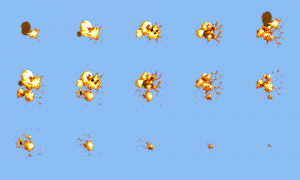Difference between revisions of "AnAL"
m (Other languages add) |
|||
| Line 24: | Line 24: | ||
* Frames: 5x3 = 15 | * Frames: 5x3 = 15 | ||
| − | + | Now let's look at how we can load this animation. For start you must download file '''AnAL.lua''' [http://love2d.org/forums/download/file.php?id=1584 from this]. Put this file in a ZIP archive with main file '''main.lua'''. Then the whole code you must write: | |
| − | Now let's look at how we can load this animation. | + | <source lang="lua"> |
| + | dofile("AnAL.lua") | ||
| + | </source> | ||
| + | Then you must load the animation source and create animation: | ||
<source lang="lua"> | <source lang="lua"> | ||
function love.load() | function love.load() | ||
Revision as of 08:23, 30 December 2011
AnAL (Animations And Love) is a library to replace 0.5.0's animations (removed in 0.6.0), with minimum code changes for the lover.
Contents
Code Changes
- love.graphics.newAnimation(...) becomes newAnimation(...)
- love.graphics.draw(anim, ...) becomes anim:draw(...)
- anim:setMode() uses string constants
Compat mode
It even features a compat mode, which adds love.graphics.newAnimation and changes love.graphics.draw.
Animations_legacy_support = true
Disadvantage is the changed behavior of love.graphics.draw, it calls a custom draw field on all tables passed.
Tutorial
Shamelessly ripped from the old 0.5.0 tutorial (on the old wiki). And now hopefully runs on 0.6.x.
This is our image, information:
- Dimensions: 480x288 px
- Frame size: 96x96 px
- Frames: 5x3 = 15
Now let's look at how we can load this animation. For start you must download file AnAL.lua from this. Put this file in a ZIP archive with main file main.lua. Then the whole code you must write:
dofile("AnAL.lua")
Then you must load the animation source and create animation:
function love.load()
-- Load the animation source.
local img = love.graphics.newImage("explosion.png")
-- Create animation.
anim = newAnimation(img, 96, 96, 0.1, 0)
end
First, we need to load the source image used for the animation. Then, we create the animation with newAnimation(). The first argument should be the source image we loaded earlier. The second is the frame width, the third is the frame height, and the fourth is the delay after each frame (in seconds). You do not need to worry about the size of the image, or the number of frames; that will be taken care of for you, if you specify number of frames as 0.
When this is done, two things remain: updating the animation, and displaying it. Updating is needed, because the animation needs to know how much time has passed in order to do frame changes. The full code for a working animation is listed below.
function love.load()
local img = love.graphics.newImage("explosion.png")
anim = newAnimation(img, 96, 96, 0.1, 0)
end
function love.update(dt)
-- Updates the animation. (Enables frame changes)
anim:update(dt)
end
function love.draw()
-- Draw the animation at (100, 100).
anim:draw(100, 100)
end
This should draw the animation at (100,100).
Moving on to animation modes. There are three predefined animation modes: loop, once and bounce. Loop is the default behavior. With this mode enabled, the animation will restart at the first frame when it reaches the end. With once mode enabled, it will play once, and then stop. Finally, with bounce the animation will reverse itself upon reaching the ends, causing it to "ping-pong" between the first and the last frame. You can set the mode like shown in the code block below.
function love.load()
local img = love.graphics.newImage("explosion.png")
anim = newAnimation(img, 96, 96, 0.1, 0)
-- Mode constants:
-- loop
-- bounce
-- once
-- Sets the mode to "bounce"
anim:setMode("bounce")
end
Docs
Function list
Following is a list of functions.
- addFrame(x, y, w, h, delay)
- setMode(mode)
- play()
- stop()
- reset()
- seek(frame)
- getCurrentFrame()
- getSize()
- setDelay(frame, delay)
- setSpeed(speed)
- getSpeed()
- getWidth()
- getHeight()
- update(dt)
Description
For the functions with arguments here are a few descriptions (the others are self-explanatory).
addFrame
- x: The x position of the frame in the image
- y: The y position of the frame in the image
- w: The width of the frame
- h: The height of the frame
- delay: How much time before going to the next frame
setMode
- mode: The mode, can be either "once", "loop" (default) or "bounce", more info in the tutorial
seek
- frame: The frame to go to in the animation
setDelay
- frame: The frame to change the delay of
- delay: How much time before going to the next frame
setSpeed
- speed: The speed of the animation, 1 being real time, 2 being twice as fast
update
- dt: Update the animation to allow it to go to the next frame.
See Also
Bartbes, creator and maintainer of AnAL.
Download link and discussion
Other Languages
Dansk –
Deutsch –
English –
Español –
Français –
Indonesia –
Italiano –
Lietuviškai –
Magyar –
Nederlands –
Polski –
Português –
Română –
Slovenský –
Suomi –
Svenska –
Türkçe –
Česky –
Ελληνικά –
Български –
Русский –
Српски –
Українська –
עברית –
ไทย –
日本語 –
正體中文 –
简体中文 –
Tiếng Việt –
한국어
More info
